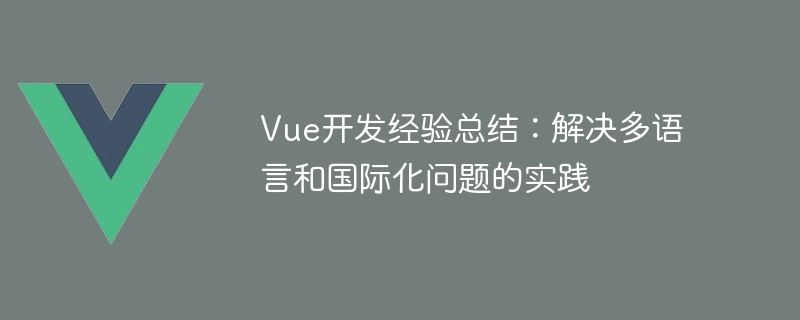

Vue.js is a popular JavaScript framework that helps developers build interactive and high-performance web applications. In development, internationalization and multi-language support are an issue that cannot be ignored, especially in projects targeting global markets. This article will help developers better cope with this challenge by sharing their experience in Vue development and summarizing the practice of solving multi-language and internationalization issues.
Vue I18n is the officially recommended international plug-in for Vue.js. It provides a complete set of solutions, including text translation , date formatting, number formatting and other functions. Using I18n in Vue only requires simple configuration and introduction to achieve multi-language switching. First, we need to install the Vue I18n plug-in:
npm install vue-i18n --save
Then, introduce the I18n plug-in into the Vue instance and configure the multi-language option:
import Vue from 'vue'
import VueI18n from 'vue-i18n'
Vue.use(VueI18n)
const messages = {
en: {
welcome: 'Welcome',
about: 'About',
contact: 'Contact'
},
zh: {
welcome: '欢迎',
about: '关于',
contact: '联系我们'
}
}
const i18n = new VueI18n({
locale: 'zh', // 设置默认语言
messages
})
new Vue({
i18n,
// ...
}) Through the above configuration, we can Use the built-in $t function for text translation:
<template>
<div>
<p>{{ $t('welcome') }}</p>
<p>{{ $t('about') }}</p>
<p>{{ $t('contact') }}</p>
</div>
</template>In addition to manually maintaining language files, we also You can choose to integrate third-party translation services, such as Google Translate API or Baidu Translation API. By calling these APIs, we can implement dynamic language translation in the project to solve the problem of real-time translation.
First, we need to register an account for a third-party translation service and obtain an API Key. Taking the Google Translate API as an example, you can use the axios library in Vue to initiate a request:
import axios from 'axios'
const apiKey = 'your_google_translate_api_key_here'
const translateText = (text, targetLanguage) => {
return axios.get('https://translation.googleapis.com/language/translate/v2', {
params: {
q: text,
target: targetLanguage,
key: apiKey
}
})
}
export { translateText }Then, call the translateText function where dynamic translation is required, and use the returned result for replacement :
import { translateText } from './translateService'
export default {
methods: {
translateContent() {
translateText('Hello', 'zh')
.then(response => {
this.translatedText = response.data.translations[0].translatedText
})
.catch(error => {
console.error(error)
})
}
}
}In international applications, we usually need to display different pictures or icons according to different language versions. In order to achieve this, we can use Webpack's require function to introduce different resource files according to different language versions. First, we need to add file processing rules to the Webpack configuration:
// webpack.config.js
module: {
rules: [
{
test: /.(png|jpe?g|gif|svg)(?.*)?$/,
use: {
loader: 'url-loader',
options: {
limit: 10000,
name: 'img/[name].[hash:8].[ext]'
}
}
}
]
}Then use require in the Vue component to introduce images in different language versions:
<template>
<div>
<img :src="require(`@/assets/${$i18n.locale}/logo.png")" alt="Summary of Vue development experience: practice in solving multi-language and internationalization issues" >
</div>
</template>Through the above configuration, our Vue application It can display different picture resources according to different language versions.
In order to improve the user experience, we can use the language detection library to automatically identify the user's language environment and automatically switch the language of the application Version. Common language detection libraries include navigator.language and window.navigator.userLanguage, etc. We can automatically set the language of the application based on this information:
import Vue from 'vue'
import VueI18n from 'vue-i18n'
import { detectLanguage } from './languageDetection'
Vue.use(VueI18n)
const browserLanguage = detectLanguage()
const i18n = new VueI18n({
locale: browserLanguage, // 自动识别用户语言
messages
})
new Vue({
i18n,
// ...
})Through the above With practice, we can make our Vue applications more user-friendly and adaptable to the global market. In actual projects, internationalization and multi-language support are areas that require in-depth research and continuous practice. I believe that with the continuous development of technology, these problems will be better solved. I hope the experience shared in this article will be helpful to you in solving multi-language and internationalization issues in Vue development.
The above is the detailed content of Summary of Vue development experience: practice in solving multi-language and internationalization issues. For more information, please follow other related articles on the PHP Chinese website!